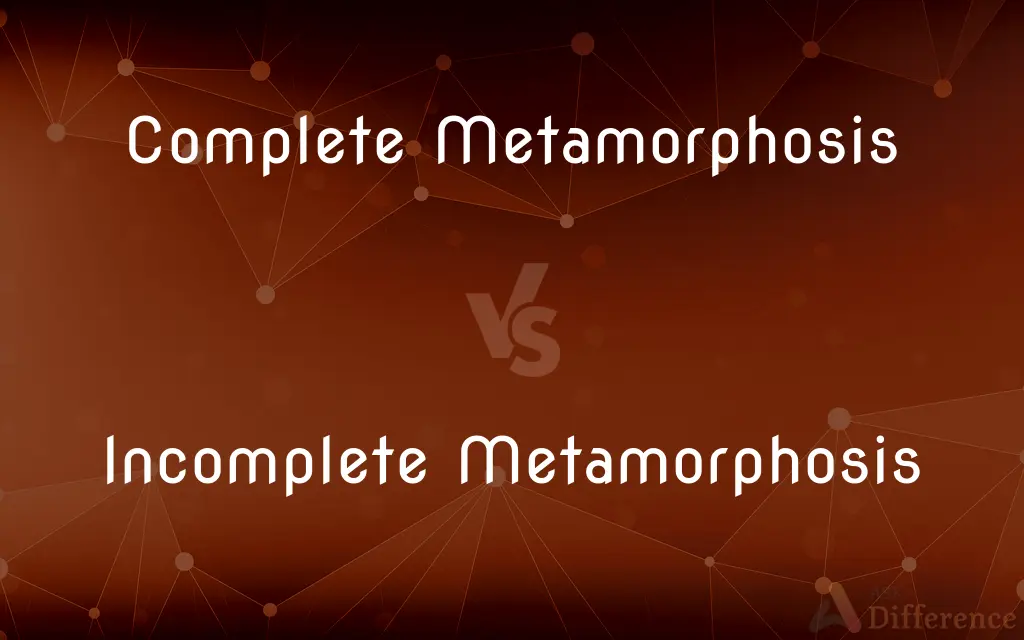Complete Metamorphosis vs. Incomplete Metamorphosis — What's the Difference?
By Tayyaba Rehman — Published on December 15, 2023
Complete metamorphosis has four stages: egg, larva, pupa, and adult; incomplete metamorphosis has three: egg, nymph, and adult.

Difference Between Complete Metamorphosis and Incomplete Metamorphosis
Table of Contents
ADVERTISEMENT
Key Differences
Complete Metamorphosis vs. Incomplete Metamorphosis: Complete metamorphosis involves a four-stage life cycle. In contrast, incomplete metamorphosis consists of only three stages without a pupal phase.
Complete Metamorphosis vs. Incomplete Metamorphosis: In complete metamorphosis, the larva looks and behaves differently from the adult. With incomplete metamorphosis, the nymph usually resembles a smaller version of the adult and matures gradually.
Complete Metamorphosis vs. Incomplete Metamorphosis: Butterflies and moths undergo complete metamorphosis, passing through a distinct pupal stage. In comparison, grasshoppers and crickets experience incomplete metamorphosis without a pupal stage.
Complete Metamorphosis vs. Incomplete Metamorphosis: The transformation from larva to adult in complete metamorphosis is drastic. In contrast, insects with incomplete metamorphosis show a more gradual change from nymph to adult.
Complete Metamorphosis vs. Incomplete Metamorphosis: In the realm of insects, complete metamorphosis is considered a more evolved trait. In contrast, incomplete metamorphosis represents an earlier stage in insect evolutionary development.
ADVERTISEMENT
Comparison Chart
Stages in Life Cycle
Four stages: egg, larva, pupa, adult
Three stages: egg, nymph, adult
Appearance Changes
Drastic change from larva to adult
Gradual maturation from nymph to adult
Examples
Butterflies, moths, beetles
Grasshoppers, crickets, cockroaches
Evolutionary Development
More evolved trait among insects
Represents an earlier evolutionary stage among insects
Dependency on External Environment
Pupal stage often static, sheltered
Nymphs often active, interacting with environment
Compare with Definitions
Complete Metamorphosis
Development involving significant morphological changes.
Through complete metamorphosis, a maggot transforms into a fly.
Incomplete Metamorphosis
Growth pattern without a pupal stage.
Incomplete metamorphosis is evident in the gradual maturation of a dragonfly.
Complete Metamorphosis
An insect growth pattern with a non-feeding pupal stage.
Complete metamorphosis includes a pupal phase during which the insect doesn't eat.
Incomplete Metamorphosis
Development with fewer morphological changes.
In the case of roaches, incomplete metamorphosis involves minimal physical alterations.
Complete Metamorphosis
An insect development process involving four distinct stages.
The butterfly's complete metamorphosis is a fascinating transformation.
Incomplete Metamorphosis
Transformation where nymphs resemble adults.
Through incomplete metamorphosis, nymphs look like miniature versions of adults.
Complete Metamorphosis
A transformation from larval to adult form with intermediary stages.
The caterpillar's transition to butterfly showcases complete metamorphosis.
Incomplete Metamorphosis
An insect's three-stage developmental process.
Grasshoppers mature through incomplete metamorphosis.
Complete Metamorphosis
A life cycle including egg, larva, pupa, and adult phases.
Studying beetles provides insight into complete metamorphosis.
Incomplete Metamorphosis
Life cycle comprising egg, nymph, and adult phases.
Crickets grow and develop via incomplete metamorphosis.
Common Curiosities
What is the main difference between larva and nymph?
Larva, found in complete metamorphosis, looks different from adults. Nymphs, in incomplete metamorphosis, resemble smaller adults.
What insects undergo complete metamorphosis?
Butterflies, moths, beetles, and flies are examples of insects that undergo complete metamorphosis.
Which metamorphic process is more evolutionarily advanced?
Complete metamorphosis is considered a more evolved trait in insects.
Are the insects active during all stages of incomplete metamorphosis?
Yes, insects are typically active during all stages of incomplete metamorphosis, unlike the pupal stage in complete metamorphosis.
Do all stages feed in incomplete metamorphosis?
Typically, yes. Unlike the pupal stage in complete metamorphosis, all stages in incomplete metamorphosis usually feed.
Can we say all insects undergo either complete or incomplete metamorphosis?
While many do, some primitive insects have even simpler life cycles without clear metamorphosis.
Is the nymph stage present in complete metamorphosis?
No, the nymph stage is characteristic of incomplete metamorphosis.
Are the changes in complete metamorphosis more drastic than incomplete?
Yes, the transformation in complete metamorphosis is more dramatic compared to the gradual change in incomplete metamorphosis.
Why don't we see the pupal stage in incomplete metamorphosis?
Incomplete metamorphosis has a more direct development without a resting or transformation phase like the pupa.
Which type of metamorphosis is found in cockroaches?
Cockroaches undergo incomplete metamorphosis.
Is the larval form in complete metamorphosis typically active?
Yes, larvae are usually active and feed voraciously to accumulate energy for the pupal stage.
How long can the pupal stage in complete metamorphosis last?
It varies among species and environmental conditions, ranging from days to months.
Which process, complete or incomplete metamorphosis, is more common among insects?
Complete metamorphosis is more common, with about 80% of insect species undergoing this process.
In which metamorphosis do we find a chrysalis or cocoon?
A chrysalis or cocoon is found in complete metamorphosis during the pupal stage.
Is incomplete metamorphosis a more primitive trait?
Yes, incomplete metamorphosis is considered an earlier evolutionary stage in insect development.
Share Your Discovery

Previous Comparison
Sagittal Plane vs. Coronal Plane
Next Comparison
GPS vs. GISAuthor Spotlight
Written by
Tayyaba RehmanTayyaba Rehman is a distinguished writer, currently serving as a primary contributor to askdifference.com. As a researcher in semantics and etymology, Tayyaba's passion for the complexity of languages and their distinctions has found a perfect home on the platform. Tayyaba delves into the intricacies of language, distinguishing between commonly confused words and phrases, thereby providing clarity for readers worldwide.
















































